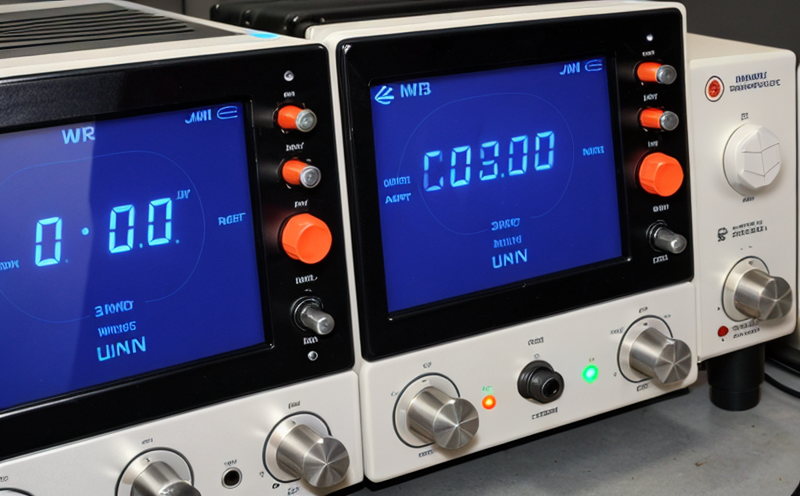EN 302 220 Narrowband IoT Device RF Testing
The European Standard EN 302 220 sets out the requirements for radio equipment, including Narrowband Internet of Things (NBIoT) devices. This standard is crucial in ensuring that IoT devices meet stringent regulatory and technical standards before they can be deployed on the market. NBIoT is a low-power wide-area network designed to connect small devices over long distances while using less power than other cellular technologies.
Testing against EN 302 220 is essential for manufacturers of IoT devices as it ensures that their products comply with European regulations, which are some of the most stringent in the world. Compliance with this standard helps avoid potential legal issues and enhances customer trust by ensuring reliable performance across different environments.
The testing process typically involves several key stages: device preparation, environmental testing, functional testing, and certification. Devices must be tested for their ability to operate within specified frequency bands, power levels, and modulation schemes. Environmental factors such as temperature, humidity, and altitude can also affect the performance of IoT devices, so these variables are carefully controlled during testing.
Functional tests ensure that the device meets all operational requirements defined by EN 302 220. These tests include checking signal strength, error rates, and other critical parameters. The goal is to verify that the device performs reliably under various conditions, including interference from other wireless signals.
The testing environment plays a crucial role in ensuring accurate results. Laboratories equipped with state-of-the-art facilities can simulate real-world conditions more accurately than ever before. Advanced measurement tools and software allow for precise analysis of test data, providing insights into how devices behave under different scenarios.
Once all tests are completed successfully, the manufacturer can apply for certification from relevant authorities. Certification not only confirms compliance with EN 302 220 but also serves as proof that your product meets high standards set by international organizations and regulatory bodies.
In conclusion, conducting thorough RF testing according to EN 302 220 ensures reliable performance of Narrowband IoT devices across diverse environments. By adhering strictly to this standard, manufacturers can build confidence among consumers and regulators alike while avoiding costly penalties associated with non-compliance.
Why It Matters
The importance of EN 302 220 compliance cannot be overstated. Non-compliance could lead to product recalls, fines, and damage to brand reputation. Regulatory authorities closely monitor adherence to these standards, ensuring that only safe and efficient devices enter the market.
Compliance with this standard also enhances interoperability between different NBIoT devices from various manufacturers. This interoperability is vital for seamless integration into existing networks and future expansions of IoT infrastructure.
Moreover, meeting EN 302 220 requirements demonstrates a commitment to quality and reliability, which are essential attributes in an increasingly connected world where trust between consumers and producers is paramount. Meeting these standards can significantly improve customer satisfaction by delivering products that consistently perform as expected.
Lastly, compliance helps reduce risks associated with substandard or faulty devices entering the market. This reduces potential health hazards and financial losses due to product failures or malfunctions. Overall, ensuring EN 302 220 compliance is not just a legal requirement but also a smart business decision.
Quality and Reliability Assurance
Ensuring quality and reliability in Narrowband IoT devices is essential for maintaining consumer trust and ensuring that products perform consistently across different environments. The testing process outlined by EN 302 220 provides a robust framework for achieving these goals.
Firstly, environmental testing ensures that devices can operate effectively under various conditions such as temperature extremes, humidity variations, and altitude changes. These tests simulate real-world scenarios where devices may be exposed to different weather patterns or operational locations.
Functional testing focuses on verifying the core functionalities of the device against predefined criteria specified in EN 302 220. This includes checking parameters like signal strength, error rates, and latency times. By performing these tests rigorously, manufacturers can identify any issues early in the development process.
Furthermore, compliance with this standard guarantees that devices meet specific technical requirements regarding frequency bands, power levels, and modulation schemes. These precise specifications ensure consistent performance across different networks and regions.
The rigorous testing procedures employed by accredited labs like ours provide peace of mind for both manufacturers and consumers alike. They reassure users that their products will function reliably regardless of where they are used or how they are deployed. Ultimately, this contributes to higher levels of customer satisfaction and loyalty towards reputable brands.
Customer Impact and Satisfaction
Meeting EN 302 220 requirements has a direct impact on customer satisfaction by ensuring that Narrowband IoT devices perform reliably in real-world conditions. Reliable performance is crucial for maintaining consumer trust and confidence, especially when dealing with connected devices that are expected to operate seamlessly across various environments.
By adhering strictly to the standards set forth in EN 302 220, manufacturers can deliver products that consistently meet or exceed expectations. This consistency fosters greater customer satisfaction because users know exactly what to expect from their purchases. When devices perform as advertised without unexpected failures or malfunctions, customers are more likely to recommend them positively.
Additionally, meeting these standards enhances interoperability between different NBIoT devices from various manufacturers. Seamless integration into existing networks and future expansions of IoT infrastructure becomes possible when all components comply with the same high standards. This interoperability is vital for creating a cohesive ecosystem where multiple devices work together harmoniously.
Lastly, compliance with EN 302 220 helps reduce risks associated with substandard or faulty devices entering the market. By ensuring that only quality products reach consumers, manufacturers protect themselves from potential health hazards and financial losses due to product failures or malfunctions. This proactive approach not only enhances brand reputation but also contributes positively to public safety.
In summary, adhering to EN 302 220 ensures reliable performance of Narrowband IoT devices across diverse environments, thereby enhancing customer satisfaction and loyalty towards reputable brands.





